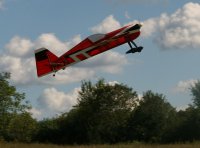njswede
150cc
[H=1]Description of the maneuver[/H]
A harrier can be seen as the most basic post-stall 3D maneuver and simply means that the plane is flown with an angle of attack that is high enough to completely stall the main wings. The result is a very slow flight with the nose pointing 30-45 degrees upward. This is an extremely important manueuver, since it is the basis for many other tricks and also serves as a transition into e.g. [wiki=The Hover]hovers[/wiki].

NJSwede harriering a [wiki]ValueHobby Sabre X[/wiki]at the GCA in New Jersey. Photo: Mike Longo
[H=2]Level of difficulty[/H]
Easy
[H=1]Performing the Maneuver[/H]
[H=2]Entering from Straight-and-Level Flight[/H]
Flying straight and level, gradually decrease throttle while increasing up elevator to increase the angle of attack. At some point around 15 degrees of angle of attack, the airframe is going to stall. Good 3D planes generally have a gentle stall, but certain airframes may experience wing-rock during the stall transition.
[H=2]Entering from Elevator[/H]
Enter into an [WIKI=The Elevator]Elevator[/WIKI] and gradually increase throttle and use the elevator to maintain angle a high (about 30 degrees) angle of attack. Keep increasing the throttle until the plane stops losing altitude and starts flying out of the Elevator while maintaining a high angle-of-attack. This method is a bit easier, since there is no stall transition.
[H=2]Steering[/H]
Steering must be done with the rudder and some amount of opposite aileron is usually needed to keep the turns flat and avoiding a sudden wing-drop.
[H=2]Exiting[/H]
Exiting is done simply by increasing throttle and easing the elevator until the plane flies straight and level again.
[H=1]Inverted Harrier[/H]
Harriers can be performed upright as well as inverted. Inverted harriers are performed exactly the same way as upright harriers, with the exception that down elevator is applied instead of up elevator.
[H=1]Related Maneuvers[/H]
[wiki]The Rolling Harrier[/wiki]
A harrier can be seen as the most basic post-stall 3D maneuver and simply means that the plane is flown with an angle of attack that is high enough to completely stall the main wings. The result is a very slow flight with the nose pointing 30-45 degrees upward. This is an extremely important manueuver, since it is the basis for many other tricks and also serves as a transition into e.g. [wiki=The Hover]hovers[/wiki].

NJSwede harriering a [wiki]ValueHobby Sabre X[/wiki]at the GCA in New Jersey. Photo: Mike Longo
[H=2]Level of difficulty[/H]
Easy
[H=1]Performing the Maneuver[/H]
[H=2]Entering from Straight-and-Level Flight[/H]
Flying straight and level, gradually decrease throttle while increasing up elevator to increase the angle of attack. At some point around 15 degrees of angle of attack, the airframe is going to stall. Good 3D planes generally have a gentle stall, but certain airframes may experience wing-rock during the stall transition.
[H=2]Entering from Elevator[/H]
Enter into an [WIKI=The Elevator]Elevator[/WIKI] and gradually increase throttle and use the elevator to maintain angle a high (about 30 degrees) angle of attack. Keep increasing the throttle until the plane stops losing altitude and starts flying out of the Elevator while maintaining a high angle-of-attack. This method is a bit easier, since there is no stall transition.
[H=2]Steering[/H]
Steering must be done with the rudder and some amount of opposite aileron is usually needed to keep the turns flat and avoiding a sudden wing-drop.
[H=2]Exiting[/H]
Exiting is done simply by increasing throttle and easing the elevator until the plane flies straight and level again.
[H=1]Inverted Harrier[/H]
Harriers can be performed upright as well as inverted. Inverted harriers are performed exactly the same way as upright harriers, with the exception that down elevator is applied instead of up elevator.
[H=1]Related Maneuvers[/H]
[wiki]The Rolling Harrier[/wiki]
Last edited by a moderator:
